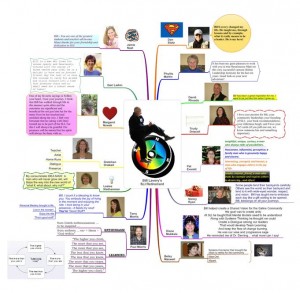An Idea Mapping Success Blogs Weblog
Idea Mapping Guidelines vs. Mind Mapping Laws – Debunking the 1 Word Per Line Law
22Sep2012 Filed under: Differences Between Idea Mapping and Mind Mapping, Idea Mapping Example Author: Jamie NastOn May 7, 2012 I wrote a post about Idea Mapping Guidelines vs. Mind Mapping Laws. Although idea mapping has a rich heritage in mind mapping, the mind map laws are sometimes restrictive, squelch creativity and/or do not enhance the purpose for creating your map.
The least realistic mind mapping law is that each branch can only have one word. Let me share the thought behind this law and then talk in practical terms.
- Ideally we want as few words as possible in our maps yet still be able to remember or communicate the ideas behind the thoughts we are putting on the branches. This helps clarity.
- A single word can generate more thoughts than a phrase. This is true but impractical for most purposes. Let me explain…
Whether your map is for personal or business purposes, how often is your central topic a single word? If you are like most it is either a picture that represents many thoughts or a description of the project, decision, presentation, plan, etc. you are mapping. Sometimes it will be a combination of an image and words.
I’ve shared just two of many idea mapping examples that would not have been able to communicate the necessary information if the creator had been restricted to one word per line. The first one details the keynote and breakout sessions for a VizThink Conference schedule and the second one compiles the thoughts from Bill Lavery’s friends for a retirement gift. Don’t let yourself be boxed into a corner by this law.
2 Responses to “Idea Mapping Guidelines vs. Mind Mapping Laws – Debunking the 1 Word Per Line Law”
Leave a reply
Idea Mapping Blog
The purpose of this blog is to share idea mapping examples and related learning from my Idea Mapping, Memory, Speed Reading, and Certification Workshops. This blog is dedicated to my Certified Idea Mapping Instructors, my clients, Mind Mapping and Idea Mapping practitioners around the globe.


![[Ask]](http://ideamapping.ideamappingsuccess.com/IdeaMappingBlogs/wp-content/plugins/bookmarkify/ask.png)
![[del.icio.us]](http://ideamapping.ideamappingsuccess.com/IdeaMappingBlogs/wp-content/plugins/bookmarkify/delicious.png)
![[Digg]](http://ideamapping.ideamappingsuccess.com/IdeaMappingBlogs/wp-content/plugins/bookmarkify/digg.png)
![[Facebook]](http://ideamapping.ideamappingsuccess.com/IdeaMappingBlogs/wp-content/plugins/bookmarkify/facebook.png)
![[Google]](http://ideamapping.ideamappingsuccess.com/IdeaMappingBlogs/wp-content/plugins/bookmarkify/google.png)
![[MySpace]](http://ideamapping.ideamappingsuccess.com/IdeaMappingBlogs/wp-content/plugins/bookmarkify/myspace.png)
![[Slashdot]](http://ideamapping.ideamappingsuccess.com/IdeaMappingBlogs/wp-content/plugins/bookmarkify/slashdot.png)
![[Sphinn]](http://ideamapping.ideamappingsuccess.com/IdeaMappingBlogs/wp-content/plugins/bookmarkify/sphinn.png)
![[StumbleUpon]](http://ideamapping.ideamappingsuccess.com/IdeaMappingBlogs/wp-content/plugins/bookmarkify/stumbleupon.png)
![[Technorati]](http://ideamapping.ideamappingsuccess.com/IdeaMappingBlogs/wp-content/plugins/bookmarkify/technorati.png)
![[ThisNext]](http://ideamapping.ideamappingsuccess.com/IdeaMappingBlogs/wp-content/plugins/bookmarkify/thisnext.png)
![[Twitter]](http://ideamapping.ideamappingsuccess.com/IdeaMappingBlogs/wp-content/plugins/bookmarkify/twitter.png)
![[Webride]](http://ideamapping.ideamappingsuccess.com/IdeaMappingBlogs/wp-content/plugins/bookmarkify/webride.png)
![[Email]](http://ideamapping.ideamappingsuccess.com/IdeaMappingBlogs/wp-content/plugins/bookmarkify/email.png)
Alexis van Dam
September 24th, 2012 at 12:40 pm
Hi Jamie,
We all know the 1 word per branch. It is hard to live by being a mindmapper. But surely one can aim to put down as little words as possible. In the retirement example you could make the text shorter and make more branches in stead of adding full sentences in a mindmap. I agree that the law can be killing creativity. So every mindmapper must decide what is more important.
jamie nast
September 27th, 2012 at 10:44 am
Hi Alexis,
I thought I replied to your comment, but now can’t find it. Didn’t want you to feel I was ignoring you. So here are my thoughts again. I totally agree that the goal most of the time is to use as few words as possible unless you have to memorize specific text or other unusual cases. In the case of the retirement example I was merely the creator of the map and the gatherer of the comments submitted by a group. My edits might have changed the meaning for those sending Bill their retirement message, so I felt like I couldn’t shorten their text.
Not only does each mind mapper have to decide what is more important, but don’t you think that can vary from map to map based on the mapper’s purpose for each individual map?
Jamie